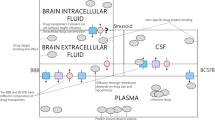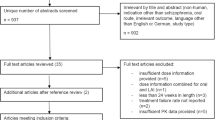Abstract
Objective
To examine the degree of innovation of the products with indications for CNS diseases approved for the European market through the centralized procedure.
Methods
This paper examines the documentation available on nine products approved by the European Medicines Evaluation Agency in its first years of activity.
Results
The Committee for Proprietary Medicinal Products approved only five products by consensus (levacetylmethadol, levetiracetam, olanzapine, pramipexole, riluzole). Four were approved by majority (entacapone, memantine, rivastigmine, zaleplon). One product received a negative opinion, and five had the application withdrawn before reaching the Committee decision.
Conclusions
An analysis of the efficacy and safety profile of these products indicates that few minor therapeutic advances have been achieved in this area. Most approved products cover needs already met, at higher cost, without substantial improvement.
Similar content being viewed by others
References
Garattini S, Bertele' V (2002) Efficacy, safety, and cost of new anticancer drugs. BMJ 325:269–271
EMEA (1999) Final opinion of the Committee for Proprietary Medicinal Products on the refusal of a marketing authorisation for Kronos. http://www.emea.eu.int/pdfs/human/opinion/06779en.pdf
EMEA (2001) Public statement on the recommendation to suspend the marketing authorisation for Orlaam (levacetylmethadol) in the European Union. http://www.emea.eu.int/pdfs/human/press/pus/877601en.pdf
Ruottinen HM, Rinne UK (1996) A double-blind pharmacokinetic and clinical dose-response study of entacapone as an adjuvant to levodopa therapy in advanced Parkinson's disease. Clin Neuropharmacol 19:283–296
Rinne UK, Larsen JP, Siden A, Worm-Petersen J (1998) Entacapone enhances the response to levodopa in parkinsonian patients with motor fluctuations. Neurology 51:1309–1314
Parkinson Study Group (1997) Entacapone improves motor fluctuations in levodopa-treated Parkinson's disease patients. Ann Neurol 42:747–755
EMEA (2000) European Public Assessment Report on Comtan. http://www.eudra.org/humandocs/humans/epar/comtan/comtan.htm
Lieberman A, Ranhosky A, Korts D (1997) Clinical evaluation of pramipexole in advanced Parkinson's disease: results of a double-blind, placebo-controlled, parallel-group study. Neurology 49:162–168
Guttman M (1997) Double-blind comparison of pramipexole and bromocriptine treatment with placebo in advanced Parkinson's disease. International Pramipexole-Bromocriptine Study Group. Neurology 49:1060–1065
EMEA (2000) European Public Assessment Report on Daquiran. http://www.eudra.org/humandocs/humans/epar/daquiran/Daquiran.htm
EMEA (2000) European Public Assessment Report on Exelon. http://www.eudra.org/humandocs/humans/epar/exelon/exelon.htm
Qizilbash N, Birks J, Lopez Arrieta J, Lewington S, Szeto S (2002) Tacrine for Alzheimer's disease (Cochrane Review). In: The Cochrane Library, issue 2. Oxford
Birks JS, Melzer D, Beppu H (2002) Donepezil for mild and moderate Alzheimer's disease (Cochrane Review). In: The Cochrane Library, issue 2. Oxford
EMEA (2002) Committee for Proprietary Medicinal Products. Summary of opinion for Ebixa. http://www.emea.eu.int/pdfs/human/opinion/0055302.pdf
Kornhuber J, Weller M (1997) Psychotogenicity and N-methyl-D-aspartate receptor antagonism: implications for neuroprotective pharmacotherapy. Biol Psychiatry 41:135–144
EMEA (2002) European Public Assessment Report on Rilutek. http://www.eudra.org/humandocs/humans/epar/rilutek/rilutek.htm
Bensimon G, Lacomblez L, Meininger V (1994) A controlled trial of riluzole in amyotrophic lateral sclerosis. ALS/Riluzole Study Group. N Engl J Med 330:585–591
Lacomblez L, Bensimon G, Leigh PN, Guillet P, Meininger V (1996) Dose-ranging study of riluzole in amyotrophic lateral sclerosis. Lancet 347:1425–1431
Bensimon G, Lacomblez L, Delumeau JC, Bejuit R, Truffinet P, Meininger V (2002) A study of riluzole in the treatment of advanced stage or elderly patients with amyotrophic lateral sclerosis. J Neurol 249:609–615
EMEA (2001) European Public Assessment Report on Sonata. http://www.eudra.org/humandocs/humans/epar/sonata/sonata.htm
Walsh JK, Fry J, Erwin CW, Scharf M, Roth T, Vogel GW (1998) Efficacy and tolerability of 14-day administration of zaleplon 5 mg and 10 mg for the treatment of primary insomnia. Clinic Drug Invest 16:347–354
Elie R, Ruther E, Farr I, Emilien G, Salinas E (1999) Sleep latency is shortened during 4 weeks of treatment with zaleplon, a novel nonbenzodiazepine hypnotic. J Clin Psychiatry 60:536–544
EMEA (2002) European Public Assessment Report on Keppra. http://www.eudra.org/humandocs/humans/epar/keppra/keppra.htm
EMEA (2001) European Public Assessment Report on Olansek. http://www.eudra.org/humandocs/humans/epar/olansek/olansek.htm
Meltzer HY (2001) Treatment of suicidality in schizophrenia. Ann N Y Acad Sci 932:44–58
Koro CE, Fedder DO, L'Italien GJ, Weiss SS, Magder LS, Kreyenbuhl J, Revicki DA, and Buchanan RW (2002) Assessment of independent effect of olanzapine and risperidone on risk of diabetes among patients with schizophrenia: population based nested case-control study. BMJ 325:243–247
Vanina Y, Podolskaya A, Sedky K, Shahab H, Siddiqui A, Munshi F, Lippmann S (2002) Body weight changes associated with psychopharmacology. Psychiatr Serv 53:842–847
Fontaine KR, Heo M, Harrigan EP, Shear CL, Lakshminarayanan M, Casey DE, Allison DB (2001) Estimating the consequences of anti-psychotic induced weight gain on health and mortality rate. Psychiatry Res 101:277–288
Acknowledgements
We are indebted to Mrs. Judy Baggott and the G.A. Pfeiffer Memorial Library Staff for helpful editorial assistance. S.G. and V.B. are, respectively, member and expert of the CPMP. The views presented in this paper are those of the authors and should not be understood or quoted as being made on behalf of the EMEA and/or its scientific committees. The works listed under "References" for each active substance refer to the EPAR on one brand product only, the first of those actually approved in alphabetical order. The web sites listed under "References" were last accessed on 11 September 2002.
Author information
Authors and Affiliations
Corresponding author
Rights and permissions
About this article
Cite this article
Garattini, S., Bertele', V. Efficacy, safety and cost of new drugs acting on the central nervous system. Eur J Clin Pharmacol 59, 79–84 (2003). https://doi.org/10.1007/s00228-003-0569-3
Received:
Accepted:
Published:
Issue Date:
DOI: https://doi.org/10.1007/s00228-003-0569-3




